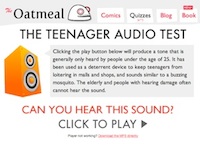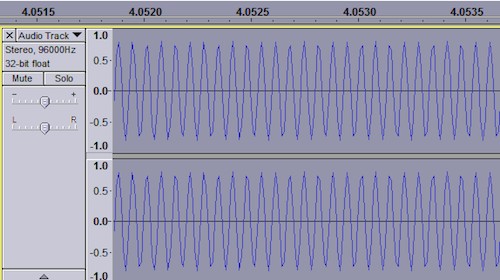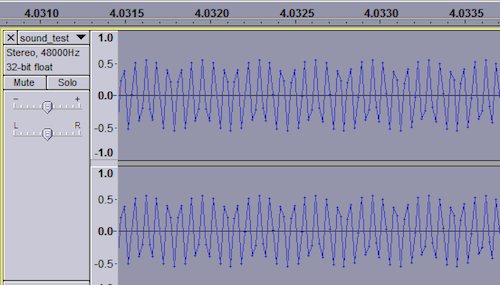Those of you who are regular readers of The Oatmeal will have noticed a recent feature: The Teenager Audio Test, otherwise known as “the Mosquito,” a mysterious sound that only youngsters can hear.
We at Easy Ear Training love anything that gets people thinking about exploring their ears, but this page left a lot to be desired. The Oatmeal explained nothing about what the Mosquito tone really is, why only some people can hear it, the damage it might do you, and why—when you click on the link—you may not even be hearing the real Mosquito sound.
 The Oatmeal is not alone in producing poor-quality features on the Mosquito; even some prestigious broadcasters have been guilty of the same thing. In this article, I’m going to bust five myths about the Mosquito, and expose some of the basic mistakes the press make when talking about it.
The Oatmeal is not alone in producing poor-quality features on the Mosquito; even some prestigious broadcasters have been guilty of the same thing. In this article, I’m going to bust five myths about the Mosquito, and expose some of the basic mistakes the press make when talking about it.
Myth 1 – The Mosquito is complex and high-tech
There’s nothing very complicated about the Mosquito sound. In fact it’s the most basic sound there is: a sine wave, which looks like this:


The Mosquito: A 15kHz Sine Wave (viewed in Audacity)
If we analyze the sample provided by The Oatmeal, then we can see that the wave goes up and down fifteen thousand times a second, meaning it has a frequency of 15,000 Hertz (15kHz in shorthand). To put that into perspective, the highest note on a full-size piano is around 4kHz, and frequency doubles for each octave you go up, so you can see that the Mosquito is about two octaves above the highest note that a piano can produce!
[If you want to know more about audio frequencies and the limits of human hearing, try our Frequency Fundamentals series.]
On to our next myth…
Myth 2 – The Mosquito is new
The Oatmeal’s reporters are far from being the discoverers of the Mosquito sound. It has been getting a lot of press coverage in recent years.
The sound gained notoriety in the UK in 2005, when Compound Security Systems of South Wales began marketing a device called “The Mosquito” as a tool to prevent gangs of young people from congregating around shops.
Some hailed this as a breakthrough in preventing antisocial behavior, while others saw it as indicating that the stereotype of young people as abusive thugs was becoming socially acceptable.
With typical ingenuity, young folks have turned the dreaded sound against old folks by using it as a mobile phone ring that parents and teachers couldn’t hear.
Though the device and surrounding publicity is fairly recent, people have known about the limits of human hearing for hundreds of years.
Myth 3 – Only people under 25 can hear it
The reason old folks are seemingly immune to the irritation of the Mosquito is something called presbycusis. That’s a fancy word you can impress your friends with at parties, but it just means the hearing loss that everyone suffers as they get older (if you were wondering: yes, that’s why your dad has the TV so loud).
The hearing loss of old age is uneven, and the highest frequencies are the first to go. Your perception of them starts to deteriorate when you hit 18 (sorry 19 year-old readers, welcome to old age! It’s all downhill from here). It also happens that not everyone is born with the ability to hear up to 15kHz, so it’s not really fair to use this loss as some kind of age test. Finally, not everyone ages in the same way. I’m over 30, and have spent decades foolishly abusing my ears playing in rock bands, but I’m still lucky enough to be able to have some perception at 15kHz (even through mild tinnitus).
The limits of your frequency perception are physical limits, and no amount of training can improve them. Fortunately however, most aspects of ear training are really about how well you have trained your brain to analyze what your ears are hearing, so limitations on the frequency range of your ears will have only a small impact on your musical potential.
Myth 4 – When I click on the link or play the ringtone, I’m hearing the Mosquito
When you listen to the track on your phone or laptop, it’s very likely that what you are hearing is not the Mosquito at all.
Let’s take a closer look at the MP3 file used by The Oatmeal test:


The MP3 version of the mosquito 15kHz tone (viewed in Audacity)
Comparing the picture immediately above to the picture at the top of the page, you can see the waveform of The Oatmeal’s MP3 file looks a bit wonky. If we use a frequency analyzer, we can see that in addition to the 15kHz signal there is also a certain amount of 3kHz noise in the track. This is because MP3 files use what’s called “lossy compression,” meaning the track is only an approximation of the original. This is a particular problem for the Mosquito, because compression does its magic by getting rid of things it thinks you might not hear, and that includes very high frequencies. In this case the 15kHz tone has survived, but is considerably distorted.
Even without compression, there are plenty of reasons why you might not hear the Mosquito.
Hi-fi companies keep costs down by focusing on the most important frequencies in music, so unless you have a very expensive hi-fi setup, it’s very likely that what you’re listening to has a very uneven frequency response at 15kHz. Check out this graph of the frequency response of Apple iPod ear buds from PC Magazine. As you can see, the headphones start to struggle at 7kHz and by 15 they’re going downhill fast. Laptop and mobile phone speakers will be even worse.
Add to that the additional problems that can be caused by the audio subsystem in your computer’s operating system, or nonprofessional soundcards with cheap digital-to-analogue converters and preamps, and you might actually be hearing more of the strange distortions of your setup than the Mosquito itself.
Even supposedly scientific TV shows, such as the BBC’s Brainiac, have made mistakes in this area, including trying to broadcast a 20kHz dog whistle even though it would be impossible for such a sound to make it through a TV broadcast chain!
If you are interested in improving your listening environment and making sure what you hear is all that it can be, check out my Easy Ear Training series Wired For Sound.
Myth 5 – What I can’t hear can’t hurt me
Not necessarily. Even if you can’t hear the tone, it will still have the potentially damaging effects on your hearing that any loud noise would. If you have trouble hearing The Mosquito, please don’t turn your headphones up to full blast, because you could be exposing yourself to the risk of hearing damage.
The scariest part of this for me is that I can imagine scenarios where people—with their babies in prams, or dogs, who cannot explain that they are feeling pain—pause and chat for a few minutes in front of shops equipped with Mosquito systems. Bear in mind that the Mosquito unit claims a maximum output of 108dB, which has a safe exposure time of only four minutes!
So where can I really test my hearing?
I would suggest a good place to start is this hearing test from the University of New South Wales. You can use it to plot the frequency response of your hearing. Don’t forget that my previous comments still apply. You will need a decent pair of headphones at the very least to get meaningful results from the test.
If you are worried about your hearing being impaired, this online test from the RNID should let you know if you need to consult a professional.
So now you know a bit more about what The Mosquito is, and the significant limitations on using it as a measure of your hearing. With the myths busted, you’re ready to take the ‘test’ – at a moderate volume, on good quality equipment, and a large pinch of salt when interpreting the result! Even better, take one of the two proper tests mentioned above. Be sure to let us know how you did in the comments below!







